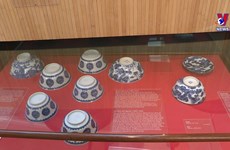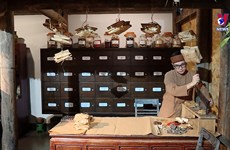New major discoveries at Hanoi’s Kinh Thien Palace
Associate Professor Tong Trung Tin, who is in charge of the excavation site, said many relics from the early Le Dynasty have been found, revealing traces of Dan Tri Courtyard and Ngu dao axis.
Of particular interest is the discovery of the Ngu dao axis from the early Le Dynasty for the first time, which was paved with large red square bricks. Next to the axis is an auxiliary side path to the east, which also coincides with the eastern side door of Doan Mon (the main gate).
“The most surprising discovery is that after digging down less than 20 inches we can already see traces of the early Le Dynasty,” said Associate Professor Tong Trung Tin. “This new discovery attracted a lot of attention because it was previously unknown what type of material the Le Dynasty had used to build the axis. But now it is clear that they are large square bricks,” he said.
At the scientific conference delivering a preliminary report on the exploratory excavation of Kinh Thien main hall this year, experts said that, from the early Le Dynasty is Dan Tri Courtyard, where the most important national ceremonies took place.
Architectural vestiges continue to be clarified within the cultural layers of the Ly and Tran Dynasties, such as traces of a large wall running in an east-west direction, sewers, lotus-shaped stones, and nearly-intact square tiled floors.
Thousands of artifacts were found during the excavation, including bricks, tiles, glazed ceramics, crockery, and household utensils from the royal palace.
Excavations this year had many important results showing that, there are many mysteries underneath the main hall of Kinh Thien Palace that need to be decoded, especially regarding the detailed and overall structure of Dan Tri Courtyard./.











